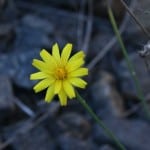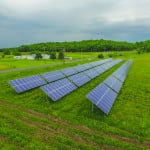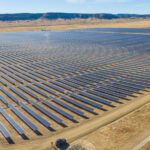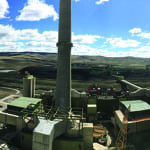Sunflower Electric Power Corp. has abandoned plans to build the $2.8 billion Holcomb Expansion after its partner on the 895-MW coal-fired power plant project in Kansas, Tri-State Generation and Transmission Association, announced it would no longer pursue the project.
Sunflower said on Jan. 15 it will allow the project’s air permit, for which it once fought hard to get—and keep—to lapse when it expires on March 27.
“Fifteen years ago, the price of natural gas was high, and wind generation was in its infancy,” said Stuart Lowry, president and CEO of Sunflower on Wednesday. “At that time, the expansion of Holcomb Station emerged as the best way to meet our members’ long-term needs for generating reliable, affordable energy.
A Slow, Painful Demise
The project got its start in August 2005, when Sunflower, a company that operates under a cooperative business model, filed for a Prevention of Significant Deterioration (PSD) air permit application to add three 700-MW supercritical pulverized coal units to the existing 360-MW Holcomb Station. The project scope was later reduced to two 700-MW units.
In 2007, the company signed a purchase option and development agreement with Tri-State Generation and Transmission Association—a Denver-based power generator owned by 43 electric cooperatives—that required Sunflower to protect the optionality of the project as long as Tri-State chose to pursue the project. Sunflower said it supported Tri-State’s efforts to market the permit to other utilities, including securing two extensions of the air permit.
In October 2007, though the Kansas Department of Health and Environment (KDHE) recommended approval of the Holcomb Expansion PSD permit, the KDHE secretary—acting in line with the administration of then-governor (and later U.S. Secretary of Health for the Obama administration) Kathleen Sebelius (D)—denied the permit based on the level of carbon dioxide emissions from the proposed plant. Between 2007 and 2009, the Kansas Legislature passed four bills to try to force approval of the permit, all of which Sebelius vetoed. In 2009, Sebelius’ successor, Mark Parkinson (D), brokered a bipartisan compromise that allowed Sunflower to resume the permitting process for one 895-MW unit. The project finally received its PSD permit in December 2010, allowing for construction to begin within 18 months.
However, in October 2013 the Kansas Supreme Court invalidated the permit, ruling in favor of the Sierra Club, which had challenged the permit. So, KDHE initiated the process to reissue the permit with modifications in January 2014, and in May that year it issued the permit to Sunflower, re-paving the way for the new supercritical coal plant to begin construction and operation. But the Sierra Club sued again in July 2014, saying the permit still violated the Clean Air Act and Kansas law. And, after much legal back-and-forth, the Kansas Supreme Court in March 2017 upheld the PSD permit.
Tri-State Introduces Responsible Energy Plan
The project ended when Tri-State on Wednesday formally announced it wouldn’t pursue the expansion. Instead, in a change that Tri-State deemed “the most transformative in its 67-year history,” it introduced an energy plan to “dramatically and rapidly advance the wholesale power supply cooperative’s clean energy portfolio and programs to serve its member electric cooperatives and public power districts.”
The Responsible Energy Plan “significantly expands renewable energy generation, meaningfully reduces greenhouse gas emissions, extends the benefits of a clean grid to cooperative members, and will share more flexibility for self-generation with members, all while ensuring reliable, affordable and responsible electricity,” the company said. “We’re not just changing direction, we’re emerging as the leader of the energy transition,” said Duane Highley, Tri-State’s CEO. “Membership in Tri-State will provide the best option for cooperatives seeking a clean, flexible and competitively-priced power supply, while still receiving the benefits of being a part of a financially strong, not-for-profit, full-service cooperative.”
Tri-State’s announcement comes just days after the company said it will retire its lone New Mexico coal-fired unit by the end of this year, and cease operations of its remaining Colorado coal units, and the company’s coal mine, by 2030. The company plans to replace that power with eight new renewable projects that will add more than 1 GW to its portfolio by 2024. They include:
Escalante Solar, a 200-MW project located in Continental Divide Electric Cooperative’s service territory in New Mexico. Tri-State has a contract with Turning Point Energy for the project. The solar project is on land near Escalante Station, which will close by the end of 2020.
Axial Basin Solar, a 145-MW project in northwest Colorado in White River Electric Association’s service territory. Tri-State has a contract with juwi for the project. The project is located on land near the Colowyo Mine, which will close by 2030.
Niyol Wind, a 200-MW project located in eastern Colorado in Highline Electric Association’s service territory. Tri-State has a contract with NextEra Energy Resources for the project.
Spanish Peaks Solar, a 100-MW project, and Spanish Peaks II Solar, a 40-MW project, located in southern Colorado in San Isabel Electric Association’s service territory. Tri-State has contracts with juwi for both solar projects.
Coyote Gulch Solar, a 120-MW project located in southwest Colorado in La Plata Electric Association’s service territory. Tri-State has a contract with juwi for the project.
Dolores Canyon Solar, a 110-MW project located in southwest Colorado in Empire Electric Association’s service territory. Tri-State has a contract with juwi for the project.
Crossing Trails Wind, a 104-MW project located in eastern Colorado in K.C. Electric Association’s service territory. Tri-State has a contract with EDP Renewables for the project.
On Wednesday, Sunflower said that as part of the Holcombe purchase option and development agreement, it could have participated in the coal plant if developed, and “would have benefitted in multiple ways in addition to the production of energy.”
“Dating back to 2000, even prior to the Holcomb Expansion Project, Sunflower worked with various project partners to capitalize on the potential operational synergies at Holcomb Station. Sunflower received fees to pursue development opportunities that have allowed us to provide energy to our member cooperatives at a cost otherwise not possible,” Lowry said. “We appreciate our working relationship with Tri-State and our other expansion partners who, like Sunflower, seek solutions to energy challenges that are in the best interest of electric cooperative members.”
—Sonal Patel is a POWER senior associate editor (@sonalcpatel, @POWERmagazine)










